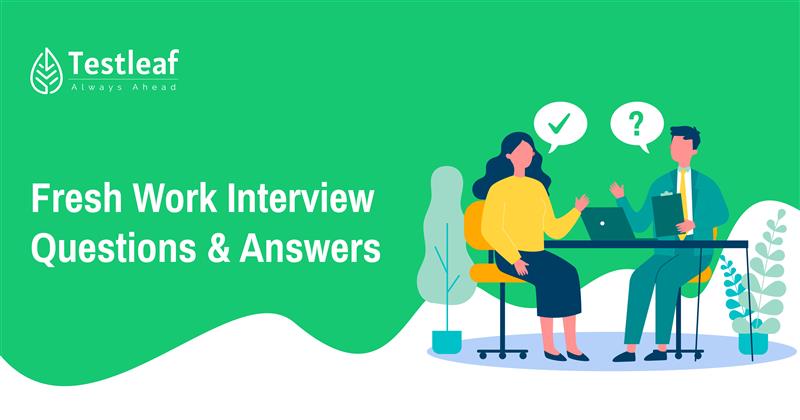Introduction
In today’s competitive tech landscape, cracking product company interviews requires more than just theoretical knowledge. Practical exposure, strong fundamentals, and tool-based expertise play a key role. Freshworks, a prominent SaaS company based in Chennai, is recognised for its rapid innovation and product-focused culture. Whether you’re applying for a role in QA, automation testing, or product support, thorough preparation for the interview process is essential. In this blog, we’ve compiled some of the most frequently asked Freshworks interview questions and answers to help you understand what the company seeks in candidates.
1. How do you identify use cases and test cases for a given feature?
- Use cases are identified from user stories or functional requirements. Test cases are derived from use cases using techniques like decision tables, equivalence partitioning, and boundary value analysis.
2. How do you ensure complete test coverage — including positive, negative, boundary, and browser compatibility scenarios?
- By mapping each requirement to test cases using a traceability matrix, and ensuring a mix of positive, negative, boundary, and compatibility tests.
Continue Reading: 2025 Top Automation Testing Infosys Interview Questions with Expert Answers
3. What is integrity testing and when do you perform it?
- It ensures data consistency and accuracy after integration, migration, or transactions.
4. What are the key components of security testing?
- Authentication, authorization, session management, input validation, data encryption, vulnerability scanning (e.g., SQL Injection, XSS).
5. How do you approach accessibility testing and what tools have you used?
- By verifying WCAG compliance using tools like Axe, Lighthouse, Wave, and testing for keyboard navigation, screen readers, and color contrast.
6. How do you determine test severity and priority for a defect?
- Severity is based on impact; priority is based on urgency. A critical crash has high severity; a typo on the homepage may have high priority.
7. What is translation testing?
- It validates UI translations in localized versions for accuracy, context, and consistency.
Related Posts: Mobile Automation Testing Interview Questions and Answers
8. Explain types of testing.
- Functional vs Non-Functional
- Black-box vs White-box
- Security Testing (subset of non-functional)
9. What is fault isolation and how do you debug issues?
- Identifying the root cause using logs, breakpoints, step-by-step reproduction, or binary search debugging.
10. Explain test planning and estimation.
- Define scope, resources, schedule, and risks. Estimation techniques: WBS, historical data, 3-point estimation.
11. What does test reporting include?
- Pass/fail status, coverage metrics, open defects, test execution trends, blocker summary.
12. What do you consider in a test environment?
- OS, browsers, network, databases, integration, tools, and data setup.
13. Difference between SDLC and STLC?
- SDLC covers the entire software development; STLC focuses on phases in testing.
14. Why is only POST used for login?
- POST is used to send sensitive data (username/password) in the body, which is more secure and does not get cached.
You Should Also Read: EPAM Interview Questions with Answers
15. Different types of authentication?
- Basic Auth
- API Key
- Bearer Token
- OAuth 1.0
- OAuth 2.0
- JWT.
16. Explain OAuth in detail.
- OAuth allows third-party apps to access user data without sharing credentials. OAuth2 involves Access Tokens, Refresh Tokens, and flows like Authorization Code Flow.
17. Difference between 401, 403, 429?
- 401: Unauthorized (invalid credentials)
- 403: Forbidden (valid but no permission)
- 429: Too Many Requests (rate limit)
18. Write request and response for GET, POST, PUT, PATCH.
- GET: No body, only URL and query params
- POST: Send JSON in body to create resource
- PUT: Send full object for update
- PATCH: Send partial fields to update
19. How do you execute tests (local, grid, Jenkins)?
- Local: Run from IDE or CLI
- Grid: Run in distributed nodes/browsers
- Jenkins: Run via pipelines on build triggers
20. Difference between implicit wait and Thread.sleep()?
- Implicit Wait: Waits for element to appear (polling)
- Thread.sleep(): Static wait (not recommended)
21. How do you handle windows, popups, and iframes?
- switchTo().window() for popups
- switchTo().frame() for iframes
- Alert handling for popups
Popular Articles: Selenium Accenture Interview Questions
22. Error message/code for wrong credentials?
- UI: “Invalid username/password”
- API: 401 Unauthorized
23. Selenium code to handle login, iframe, popup:
WebDriver driver = new ChromeDriver();
driver.get(“loginPageUrl”);
driver.findElement(By.id(“username”)).sendKeys(“user”);
driver.findElement(By.id(“password”)).sendKeys(“pass”);
driver.findElement(By.id(“loginBtn”)).click();
String parent = driver.getWindowHandle();
for(String win : driver.getWindowHandles()) {
if(!win.equals(parent)) {
driver.switchTo().window(win);
}
}
driver.switchTo().frame(“loginFrame”);
driver.findElement(By.id(“email”)).sendKeys(“xyz”);
24. File upload/download, browser interactions:
- Use sendKeys(path) for upload
- Use Robot class or AutoIT for OS dialogs
25. Solve a problem (OOPS, optimization):
- Use classes, encapsulation
- Implement algorithms with test cases
- Analyze time complexity (Big O)
Conclusion
Cracking a Freshworks interview involves more than just theoretical knowledge; it demands practical problem-solving skills, clear communication, and a good grasp of tools and frameworks relevant to the role. The questions provided here are designed to prepare you for real-world expectations. With proper preparation, you’ll be well-equipped to succeed at Freshworks or any other leading tech company.
If you’re new to testing or aiming to improve your skills, enrolling in an online software testing course can give you a solid foundation and practical experience to approach such interviews confidently.
We Also Provide Training In:
- Advanced Selenium Training
- Playwright Training
- Gen AI Training
- AWS Training
- REST API Training
- Full Stack Training
- Appium Training
- DevOps Training
- JMeter Performance Training
Author’s Bio:

As CEO of TestLeaf, I’m dedicated to transforming software testing by empowering individuals with real-world skills and advanced technology. With 24+ years in software engineering, I lead our mission to shape local talent into global software professionals. Join us in redefining the future of test engineering and making a lasting impact in the tech world.
Babu Manickam
CEO – Testleaf





